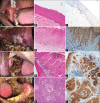Role of S100 A7 as a diagnostic biomarker in oral potentially malignant disorders and oral cancer
- PMID: 35968185
- PMCID: PMC9364636
- DOI: 10.4103/jomfp.jomfp_402_20
Role of S100 A7 as a diagnostic biomarker in oral potentially malignant disorders and oral cancer
Abstract
Background: S100 proteins have been implicated in the tumorigenesis of different human cancers and in oral dysplasia, as they are keratinocytes.
Materials and methods: In the present study, we have attempted to compare the expression of S100-A7 within young-onset (age ≤45 years, Group 1) oral squamous cell carcinoma (OSCC), OSCC in older age groups (age >45 years Group 2), oral potentially malignant disorders (OPMDs, Group 3) and inflammatory lesions (Group 4). The tissue sections were scored based on the percentage of immunostained cells and staining intensity. Nuclear, cytoplasmic and membrane immunoreactivity were also scored.
Results: The present study comprised 153 histopathologically diagnosed case subjects of OSCC >45 years (n = 41), OSCC <45 years (n = 36), OPMD (n = 40) and inflammatory lesions (n = 36). The present study revealed a statistically significant difference of distribution with regard to S100A7 staining (cytoplasmic and nuclear) between OPMDs and OSCC (P < 0.05). The nuclear, cytoplasmic and membrane staining as well as the staining intensity had significantly different scoring patterns among the OSCC group, OPMD group and the inflammatory lesions with the OSCC group having the highest scoring of the S100A7 staining (irrespective of the age).
Conclusions: The present study concludes that S100A7 can be used as a diagnostic biomarker to differentiate between OPMDs and OSCC lesions. However, the marker is unable to distinguish between OSCCs in younger and older patients as the molecular pathogenesis of tumors in either of these age groups is probably similar.
Keywords: Biomarker; immunohistochemistry; oral potentially malignant disorders; oral squamous cell carcinoma.
Copyright: © 2022 Journal of Oral and Maxillofacial Pathology.
Conflict of interest statement
There are no conflicts of interest.
Figures

References
-
- Warnakulasuriya S. Global epidemiology of oral and oropharyngeal cancer. Oral Oncol. 2009;45:309–16. - PubMed
-
- van Monsjou HS, Wreesmann VB, van den Brekel MW, Balm AJ. Head and neck squamous cell carcinoma in young patients. Oral Oncol. 2013;49:1097–102. - PubMed
-
- Marshall JR, Graham S, Haughey BP, Shedd D, O’Shea R, Brasure J, et al. Smoking, alcohol, dentition and diet in the epidemiology of oral cancer. Eur J Cancer B Oral Oncol. 1992;28B:9–15. - PubMed
-
- Javadi P, Sharma A, Zahnd WE, Jenkins WD. Evolving disparities in the epidemiology of oral cavity and oropharyngeal cancers. Cancer Causes Control. 2017;28:635–45. - PubMed
LinkOut - more resources
Full Text Sources
Research Materials
